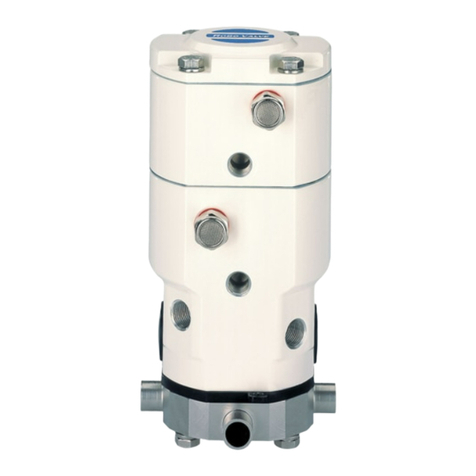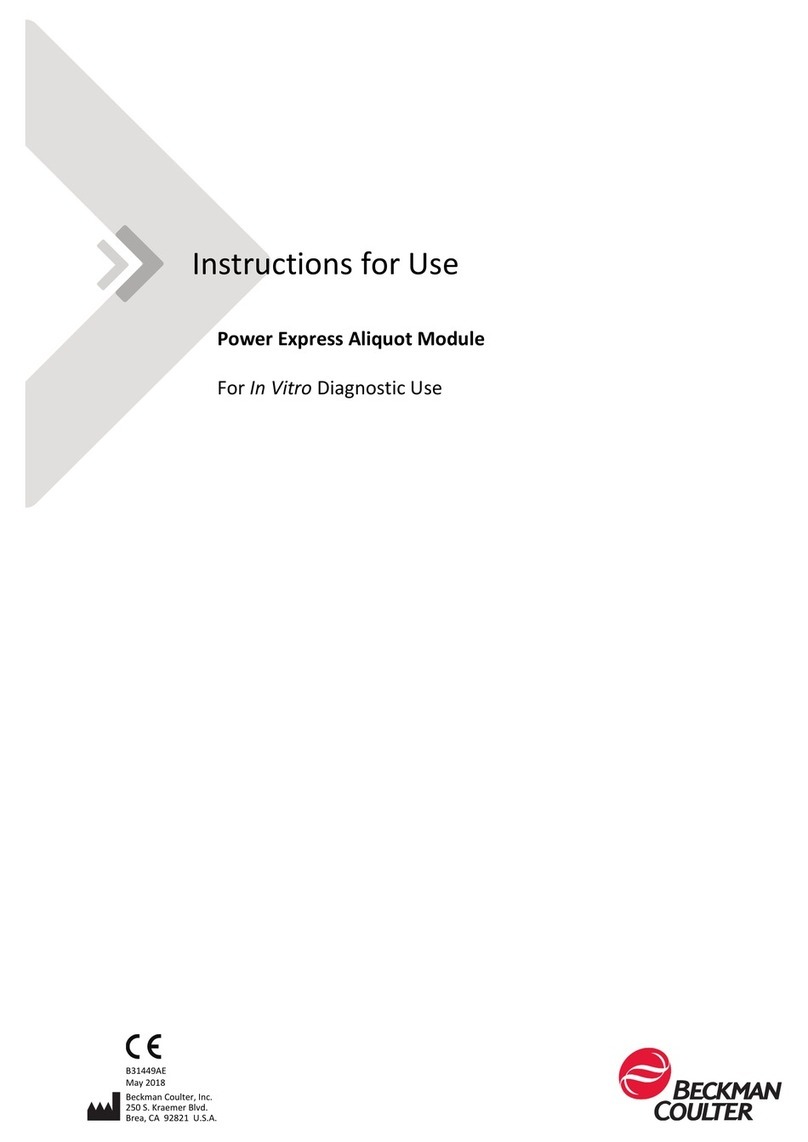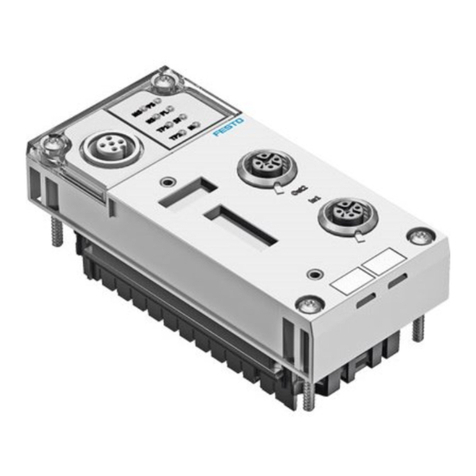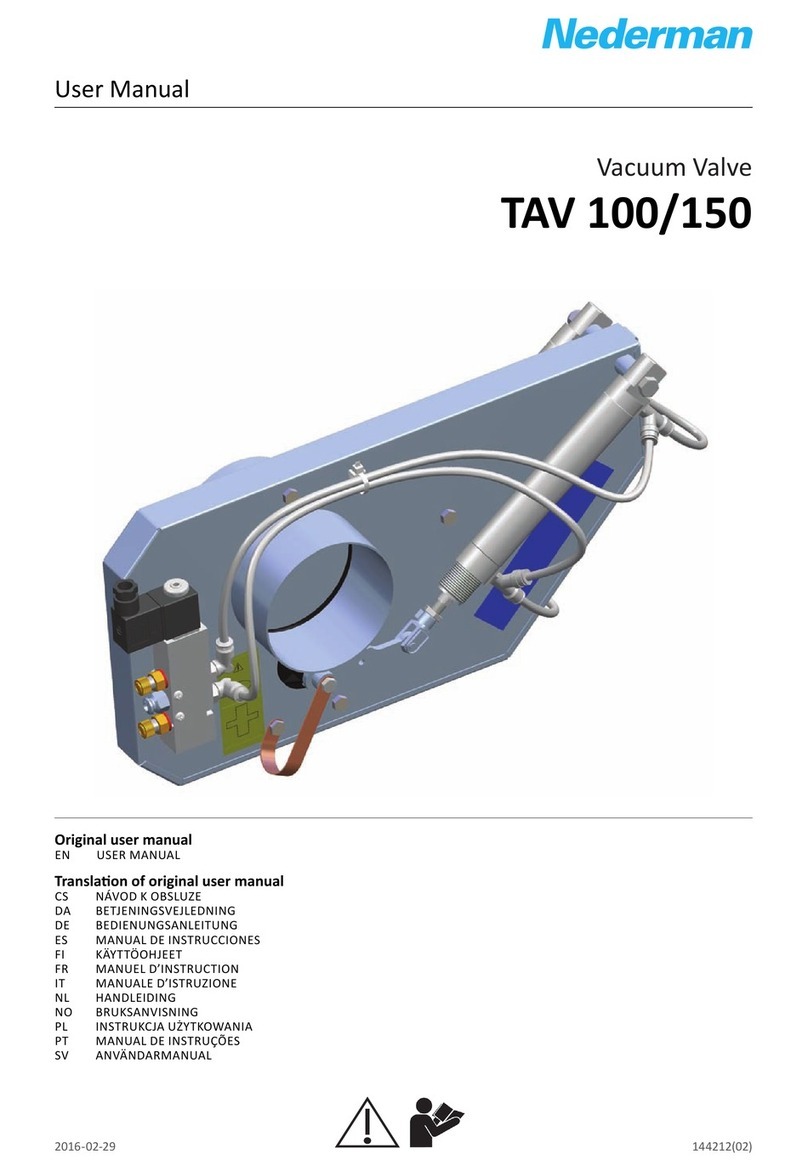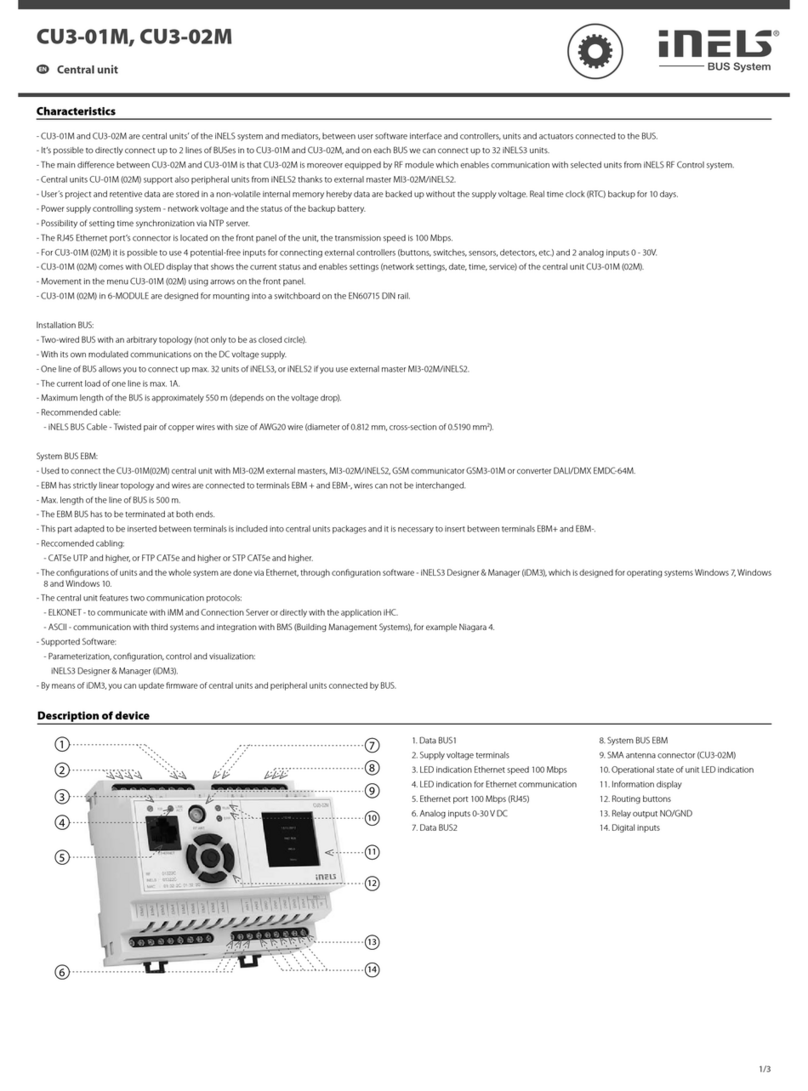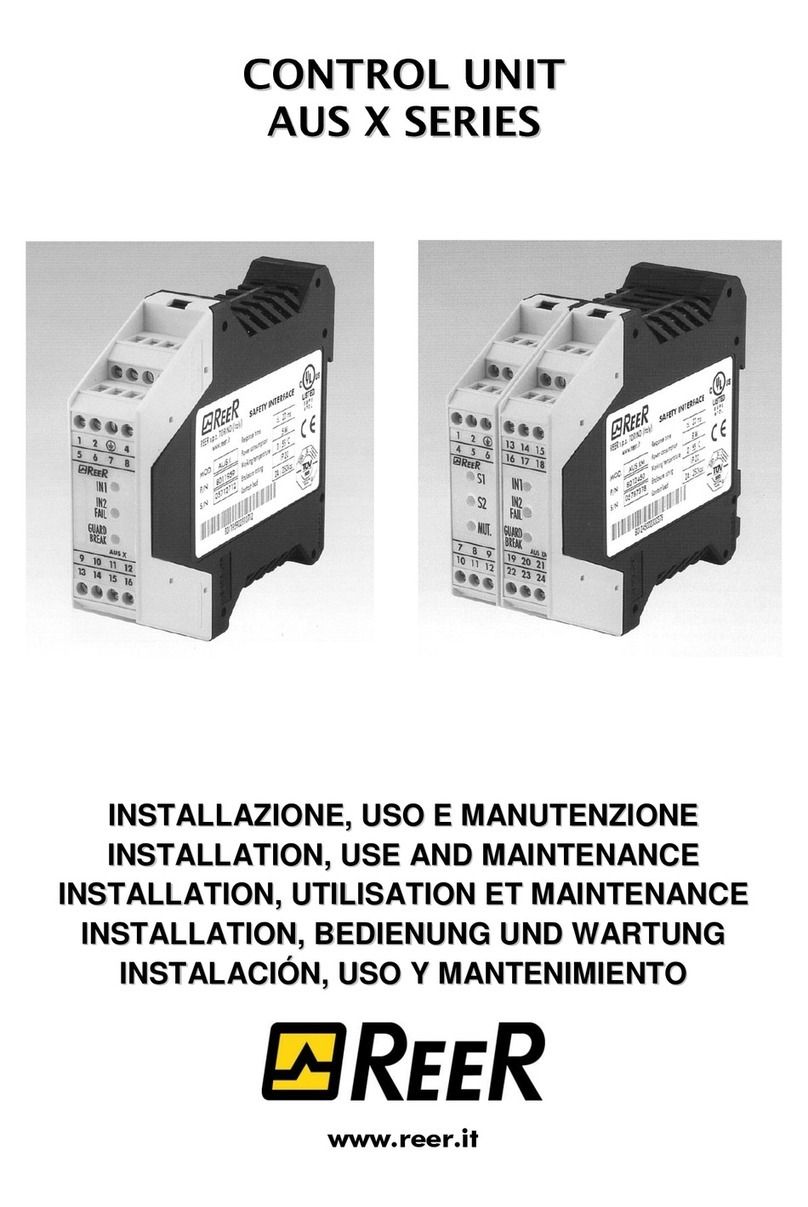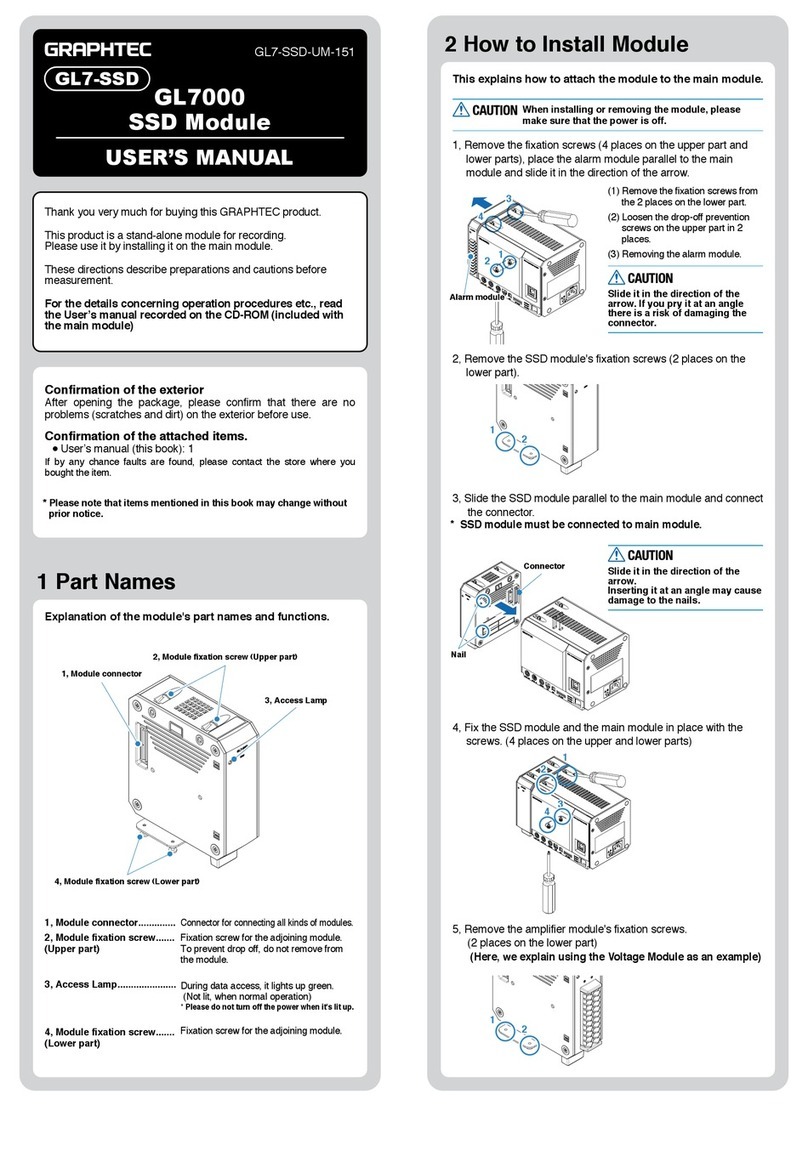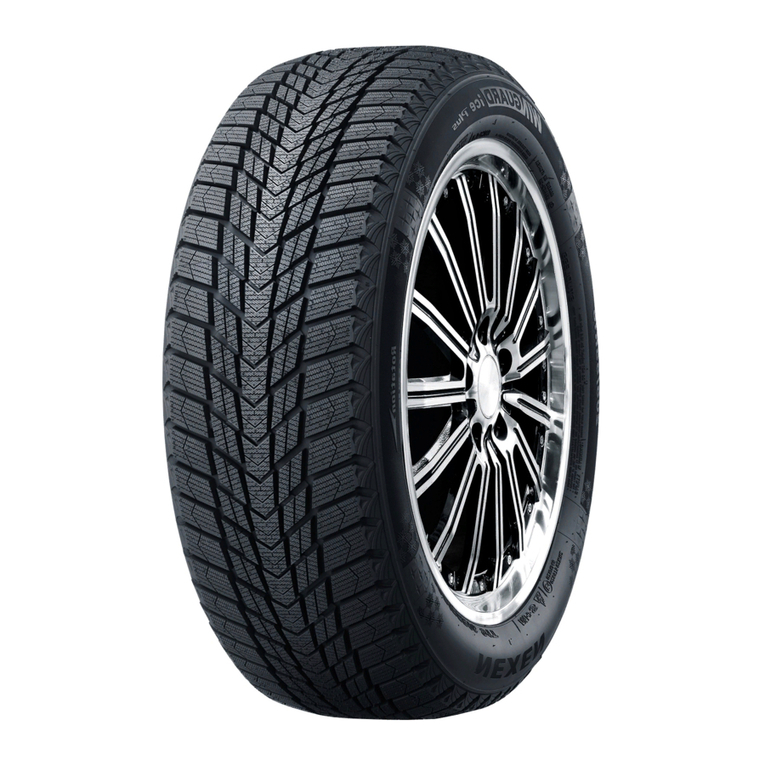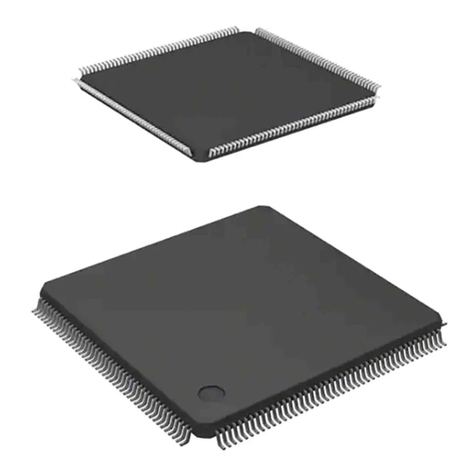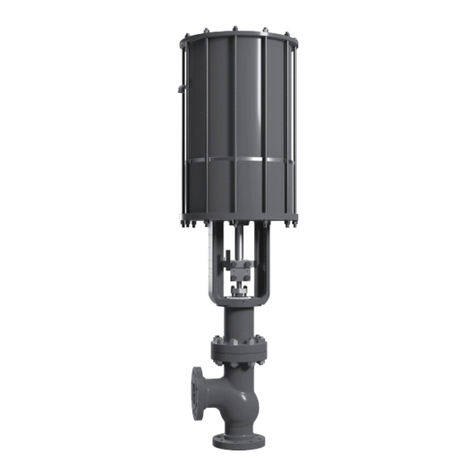Tegam 1805B User manual

MODEL 1805B
RF Control Unit
Instruction Manual
P/N IM200-CD
Rev. J
This owner’s manual was as current as possible when this product was manufactured. However,
products are constantly being updated and improved. Because of this, some differences may occur
between the description in this manual and the product you received.
TEGAM, INC.
TEN TEGAM WAY
GENEVA, OH 44041
TEL: (440) 466-6100
FAX: (440) 466-6110
www.tegam.com
Publication Date: January 2014

SAFETY SUMMARY
DEFINITIONS
The following definitions apply to WARNINGS, CAUTIONS, and NOTES found
throughout this manual.
Highlights an operating or maintenance procedure, practice, statement, condition, etc.,
which, if not strictly observed, could result in injury and/or death of personnel. Do not
proceed beyond a WARNING symbol until all the indicated conditions have been fully
understood and/or met.
CAUTION
Highlights an operating or maintenance procedure, practice, statement, condi-
tion, etc., which, if not strictly observed, could result in damage or destruction of
the equipment. Do not proceed beyond a CAUTION symbol until all the indicat-
ed conditions have been fully understood and/or met.
NOTE
Highlights an essential operating or maintenance procedure, condition, or
statement that must be highlighted.
GENERAL PRECAUTIONS
The following are general precautions that are not related to any specific pro-
cedure and, therefore, do not appear elsewhere in this publication. These are
precautions that personnel must understand and apply during various phases
of instrument operation or service.
Potentially lethal voltages are present in this instrument. Serious shock haz-
ards from voltages above 70 volts may exist in any connector, chassis, or cir-
cuit board. Observe the following precautions:
• Use the buddy system any time work involving active high voltage components is
required. Turn OFF the power before making/breaking any electrical connection.
Regard any exposed connector, terminal board, or circuit board as a possible shock
hazard. DO NOT replace any component or module with power applied.
• If test conditions to live equipment are required, ground the test equipment
before probing the voltage or signal to be tested.
• Personnel working with or near high voltage should be familiar with modem
methods ofresuscitation.
• DO NOT wear jewelry (rings, bracelets, metal watches, and/or neck chains)
while working on exposed equipment. Be very cautious about using hand tools
near exposed backplanes, bus bars, and/or power supply terminals. Use properly
insulated tools. When making test connections to the power supply terminals and
bus bars; use only insulated probe tips.
• Verify that the instrument is set to match the available line voltage and the correct
fuse is installed.
• DO NOT install substitute parts or perform any unauthorized modification to this
i
WARNING
WARNING
!
!
!

instrument. Contact TEGAM to acquire any information on replacement parts or
returning the instrument for repair. Unauthorized modification can cause injury to
personnel and/or destruction of the instrument.
• Operating personnel must not remove instrument covers. Component replacement
or adjustments MUST BE performed by qualified service personnel.
• DO NOT operate the instrument near or in the presence of flammable gases or
fumes.
DETAILED PRECAUTIONS
The following WARNING, CAUTIONS and NOTES appear throughout the text of this
manual and are repeated here for emphasis.
!CAUTION
• All procedures and steps identified as be followed exactly as written
and according to ESDS device handling procedures. Failure to comply WILL
RESULT IN ESDS damage.
• DO NOT use a nylon bristle brush in the solvent as the bristles may dissolve and
cause damage to the circuit card or component.
• DO NOT use ultrasonic cleaning on parts or assemblies containing electrical or
electronic components.
• Compressed air used for cleaning and/or drying can create airborne particles that
may enter the eye. Goggles/faceshields should be worn. DO NOT direct air stream
towards self or other personnel. Pressure should be restricted to a maximum of
15 psi to avoid personal injury.
• Under no circumstances should a wire brush, steel wool, or abrasive compound
be used on any surface. Using these items will cause extensive damage to the
instrument surface.
NOTE
DO NOT return any instrument or component to TEGAM without receiving prior
factory authorization.
SAFETY SYMBOLS
The following symbols are used to identify safety hazards found throughout this
publication and/or located on the instrument.
ii
CAUTION
HIGH VOLTAGE
Protective Conductor
Terminal
Caution,
Risk of Electrical Shcok

Table of Contents
SAFETY SUMMARY
Definitions............................................................................................................................. i
General Prcautions.............................................................................................................. i
Detailed Precautions........................................................................................................... ii
Safety Symbols................................................................................................................... ii
LIST OF ILLUSTRATIONS...............................................................................................................v
LIST OF TABLES............................................................................................................................ vi
SECTION I
INTRODUCTION AND GENERAL DESCRIPTION
INTRODUCTION.......................................................................................................................... 1-1
Purpose.......................................................................................................................... . 1-1
Scope ............................................................................................................................. 1-1
Arrangement.................................................................................................................... 1-1
Related Manuals...............................................................................................................1-1
Contacting TEGAM.......................................................................................................... 1-2
Electrostatic Discharge Sensitive.....................................................................................1-2
Abbreviations and Acronyms.............................................................................................1-3
Safety Considerations.......................................................................................................1-3
GENERAL DESCRIPTION............................................................................................................1-3
Description of Equipment..................................................................................................1-3
Functional Description................................................................................................ 1-3
Physical Description....................................................................................................1-3
Specifications................................................................................................................... 1-4
Recommended Materials................................................................................................. 1-5
Special Tools and Test Equipment................................................................................... 1-5
APPLICATIONS.............................................................................................................................1-5
SECTION II
INSTALLATION AND SHIPMENT
GENERAL .................................................................................................................. .............2-1
Initial Inspection.................................................................... ........................................... 2-1
Inspection.................................................................................................................... 2-1
Damage....................................................................................................................... 2-1
Power Requirements .......................................................................................................2-1
Environmental Requirements........................................................................................... 2-1
Recommended Operating Environment........................................................................... 2-1
PREPARATION FOR USE ............................................................................................................2-2
Mounting Instructions....................................................................................................... 2-2
Initial Setup ..................................................................................................................... 2-2
Input/Output Options........................................................................................................ 2-2
MOUNT BIAS (+/-) Terminals (E1 and E2)..........................................................2-3
TEMPERATURE CONTROL Connector (J1).......................................................2-3
+ AM MODULATION Connector (J2).................................................................. 2-3
IEEE-488 INTERFACE BUS (J3)........................................................................ 2-4
REMOTE PROGRAM—INPUT Connector (J4).................................................. 2-4
-AM MODULATION Connector (J6).....................................................................2-5
Power Input Assembly (XF1).............................................................................. 2-5
iii

Line Voltage and Fuse Selection..................................................................................... 2-5
PREPARATION FOR RESHIPMENT OR STORAGE ..................................................................2-8
Reshipment...................................................................................................................... 2-8
Storage............................................................................................................................. 2-9
SECTION III
THEORY AND OPERATION
GENERAL ..............................................................................................................................3-1
OPERATION ...............................................................................................................................3-1
GENERAL OPERATING CONSIDERATIONS.............................................................................. 3-2
CONTROLS AND INDICATORS ...................................................................................................3-2
LISTEN Indicator.............................................................................................................. 3-3
REMOTE Indicator............................................................................................................3-3
STANDBY Indicator.......................................................................................................... 3-3
POWER Switch................................................................................................................ 3-3
ON Indicator..................................................................................................................... 3-3
DC SUBSTITUTED POWER Switch............................................................................... 3-3
RF ON Indicator............................................................................................................... 3-3
BRIDGE BALANCE Meter............................................................................................... 3-3
RF OFF Indicator.................................................................................................. ............3-4
FINE NULL ADJUST Control........................................................................................... 3-4
COARSE NULL ADJUST Control.................................................................................... 3-4
ERROR Indicator............................................................................................................. 3-4
RF ON/OFF Switch...........................................................................................................3-4
TEMPERATURE Meter.....................................................................................................3-4
ADDRESS Switch............................................................................................................ 3-4
OPERATING INSTRUCTIONS..................................................................................................... 3-5
Initial Powerup and Checkout.......................................................................................... 3-5
Manual Operation............................................................................................................ 3-6
REMOTE OPERATION.................................................................................................... 3-7
TERMINATING OPERATION........................................................................................... 3-8
THEORY OF OPERATION ...........................................................................................................3-8
Power Supply/Motherboard Section................................................................................ 3-8
Microprocessor Section................................................................................................... 3-9
RF Amplifier Section...................................................................................................... 3-11
Thermistor Mount Proportional Temperature Controller................................... 3-11
Bridge Offset Sensing Circuit............................................................................ 3-12
RF Switching Circuitry....................................................................................... 3-12
DC Substitution Section................................................................................................. 3-12
CALIBRATION............................................................................................................................. 3-13
DC Substitution.............................................................................................................. 3-13
Calibration Factors......................................................................................................... 3-13
Sources of Calibration Error........................................................................................... 3-14
Calibration Factor in dB................................................................................................. 3-14
SECTION IV
TESTING
GENERAL ..............................................................................................................................4-1
MAINTENANCE ............................................................................................................................4-1
Inspection................................................................ ........................................................ 4-1
Preventive Maintenance.................................................................................................. 4-1
Connectors................................................................................................................. 4-1
Calibration Data Record .............................................................................................4-1
Special Cleaning Instructions........................................................................................... 4-1
iv

Microwave Coaxial Cable Assemblies..............................................................................4-1
Circuit Cards and Modules ...............................................................................................4-1
Machined Surfaces and Hardware ...................................................................................4-2
Chassis Cleaning..............................................................................................................4-3
Connector Cleaning......................................................................................................... 4-3
PERFORMANCE TESTING...........................................................................................................4-4
Initial Test Setup............................................................................................................... 4-4
DC Substitution Accuracy Test......................................................................................... 4-4
BIAS Power Range Test................................................................................................... 4-5
Temperature Control Circuit Verification........................................................................... 4-6
System IIA Closed Loop Stability Test.............................................................................. 4-6
CONTACTING TEGAM..................................................................................................................4-9
WARRANTY...................................................................................................................................4-9
List of Illustrations
RF Control Unit, Model 1805B ..................................................................................................... 1-1
Model 1805B Assembly Location.................................................................................................. 1-4
Typical Configuration..................................................................................................................... 1-6
10 mW Configuration Using Model 1727A.................................................................................... 1-8
SWR Measurement Configuration ................................................................................................ 1-8
75 Ohm Sensor Calibration Setup................................................................................................. 1-9
Typical Higher Power Calibration Setup........................................................................................ 1-9
Spectrum Analyzer Calibration Setup.......................................................................................... 1-10
Physical Dimensions.................................................................................................................... 1-11
Model 1805B/1807A Bench Configuration.................................................................................... 2-2
Model 1805B Connector Location (FRONT)................................................................................. 2-3
Model 1805B Connector Location (REAR)................................................................................... 2-4
IEEE-488 INTERFACE BUS Pin Location.................................................................................... 2-4
Voltage Selector/Fuse Assembly................................................................................................... 2-6
Precision Power Source Setup..................................................................................................... 2-7
Precision Power Source Setup..................................................................................................... 2-8
Controls and Indicators (FRONT)................................................................................................. 3-2
Controls and Indicators (REAR).................................................................................................... 3-5
Important Interface Dimensions Type 7mm...................................................................................A-2
Important Interface Dimensions Type 2mm...................................................................................A-3
Important Interface Dimensions Type BNC...................................................................................A-3
Important Interface Dimensions Type BNC...................................................................................A-4
Important Interface Dimensions Type BNC...................................................................................A-4
v

Address Switch ................................................................................................................3-5
Simplified Microprocessor Block Diagram....................................................................... 3- 9
Precision Power Source Schematic................................................................................ 3-10
RF Amplifier Functional Diagram.................................................................................... 3-11
Temperature Control Circuitry......................................................................................... 3 -11
Simplified dc Substitution Circuitry................................................................................. 3-13
Closed Loop Stability Test................................................................................................ 4-6
Removal and Installation ...................................................................................................4-7
LIST OF TABLES
Specifications ................................................................................................................ 1-1
Recommended Consumable Materials ........................................................................... 1-2
Special Tools and Test Equipment .................................................................................. 1-3
IEEE-488 INTERFACE BUS Signal Designators .............................................................2-1
Line Voltage Fuse Requirements......................................................................................2-2
Mnemonics for Remote Control ...................................................................................... 3-1
Inspection ...............................................................................................................4-1
Dc Substituted Power Settings..........................................................................................4-2
Pin Height Specification.....................................................................................................A-1
Connector Torque Recommendations...............................................................................A-2
APPENDIX A
CARE and HANDLING of Microwave Coaxial Cable Assemblies
Care and Handling of Assemblies.....................................................................................A-1
Cable Inspection................................................................................................................A-1
Making Initial Connections.................................................................................................A-2
Aligning Connectors......................................................................................................A-2
Mating Connectors........................................................................................................A-4
Ensuring Proper Connector Torque..................................................................................A-5
Overtorquing.................................................................................................................A-5
Hex-Nut Types..............................................................................................................A-5
Knurled Nuts.................................................................................................................A-5
Proper Cable Handling......................................................................................................A-5
Securing Cables.......................................................................................................... .A-6
Storing Cables.............................................................................................................. A-6
Cleaning Connector Interfaces..........................................................................................A-6
vi

Operation & Service Manual Section I
Model 1805B RF Control Unit Introduction and General Description
SECTION INTRODUCTION AND GENERAL DESCRIPTION
INTRODUCTION
PURPOSE
This manual provides Operation and Service instructions necessary to install, service,
test, and operate the TEGAM Model 1805B RF Control Unit (P/N 138-415-1).
SCOPE
This manual is to be used in conjunction with the operation and maintenance of the
RF Control Unit. The manual also provides a description of each assembly; testing of
the unit; maintenance procedures to maintain the instrument.
ARRANGEMENT
The information contained in this manual is tabulated in the Table of Contents, List
of Illustrations, and List of Tables. The manual is divided into four sections, listed as
follows:
SECTION I Introduction and General Description
SECTION II Installation and Shipment
SECTION III Theory and Operation
SECTION IV Testing
Figure 1-1 RF Control Unit, Model 1805B
RELATED MANUALS
The following manuals contain information that may be used in conjunction with
this manual to operate, or calibrate the RF Transfer Standard.
1-1

Operation & Service Manual Section I
Model 1805B RF Control Unit Introduction and General Description
Manual Title
IM128 Models 1109, 1109H and 1110 Coaxial Power Standards, Operation
and Service Manual
IM198 System IIA, Automatic Power Meter/Sensor Calibration System,
Opertion and Service Manual
IM199 Model 1807A RF Transfer Standard, Operation and Service Manual
IM205 Models 1111 and 1116 Coaxial Power Standards, Operation
and Service Manual
IM241 Models 1119, 1119H and 1120 Coaxial Power Standards, Operation
and Service Manual
IM245 Models 1117A, 1117A and 1118 Coaxial Power Standards, Operation
and Service Manual
IM249 Operation Manual, SWR Measurement Kit (P/N 187-4003)
IM255 Operation Manual, 50-75 W Minimum Loss Matching Pad (P/N 138-
650)
IM267 Model 1727A, Amplifier, Operation and Service Manual
CONTACTING TEGAM
In the event of an instrument malfunction, contact TEGAM. An apparent malfunction of
an instrument or component may be corrected over the phone by contacting TEGAM.
DO NOT send the instrument or component back to the factory without prior authoriza-
tion. When it is necessary to return an item, state the symptoms or problems, catalog
and type number of the instrument or component, serial number of the item, and date of
original purchase. Also write the company name, your name, and phone number on an
index card. Then attach the card to the instrument or component to be returned. Or
contact TEGAM using the following:
TEGAM, INC. 800-666-1010 toll-free
TEN TEGAM WAY 440-466-6100 phone
GENEVA, OH 44041 USA 440-466-6110 fax
ELECTROSTATIC DISCHARGE SENSITIVE
The equipment documented in this manual contains certain Electrostatic Discharge
Sensitive (ESDS) components or parts. Therefore, certain procedures/steps are
identified by the use of the symbol . This symbol is used in two ways:
!CAUTION
All procedures and/or steps identified as must be followed exactly as written and
according to ESDS device handling procedures. Failure to comply WILL RESULT IN
ESDS damage.
a. When the ESDS symbo l is placed between a paragraph number and
title, all of that paragraph, including all subparagraphs, is considered an
ESDS device handling procedure.
b. When the ESDS symbol is placed between a procedure/step number
and the text, all of that procedure is considered an ESDS device handling
procedure.
1-2

Operation & Service Manual Section I
Model 1805B RF Control Unit Introduction and General Description
ABBREVIATIONS AND ACRONYMS
The following list contains all abbreviations used throughout this manual. Abbreviations and
acronyms that are not listed conform with MIL-STD-12D.
DUT Device Under Test
ESDS Electrostatic Discharge Sensitive
SAFETY CONSIDERATIONS
The RF Control Unit and all related documentation must be reviewed for familiarization with
safety markings and procedures before performing any operation and/or service. Refer to the
SAFETY SUMMARY located at the beginning of this manual for a summary of safety
information and procedures. Following these simple safety precautions will ensure safe
operation and service of the RF Control Unit.
GENERAL DESCRIPTION
DESCRIPTION OF EQUIPMENT
The following paragraphs provide a general description of the RF Control Unit (shown in
Figure 1-1).
Functional Description
The Model 1805B RF Control Unit is a solid state, microprocessor-controlled RF control unit
designed for precise control ofdc substituted power. When used with thermistor mounts such
as the TEGAM Model 1109,1109H, 1116,1117A, 1119 and 1119H Feedthrough Thermistor
Mounts and a stable RF generator, a system is obtained which allows rapid and accurate
calibration of power meter/sensors and other thermistor mounts from 100 KHz to 26.5 GHz.
Model 1805B also provides:
• IEEE-488 Bus or front panel selection of precise dc power levels. These levels are 0.5
mW and 1-10 mW in 1 mW steps.
• IEEE-488 Bus or front panel RF ON/OFF switching.
• Elimination ofac/dc error by using dc for both bias and substituted power.
• Automatic control of dc level to within ±0.1% +1 mW.
• Constant dc level over an ambient temperature range of from +10° to +40°C.
• Capability to correct RF source level variations of ±3 dB.
• Internal temperature controller for controlling internal temperature of thermistor mount.
Physical Description
Refer to Table 1 -1 for all the physical dimensions for the RF Control Unit, Model 1805B. The
RF Control Unit features a POWER ON/OFF/STANDBY switch/indicators, a
TEMPERATURE control meter, a RF ON/OFF switch/indicator, DC SUBSTITUTED
POWER (mW) control, BRIDGE BALANCE meter, MOUNT BIAS connectors,
REMOTE/LISTEN/ERROR indicators, and FINE/COARSE NULL ADJUST controls, which
are all located on the front panel. The rear panel contains the input power connector and fuse
selector assembly, INPUT/OUTPUT REMOTE PROGRAM connectors, ADDRESS selector
switch, IEEE 488 INTERFACE BUS connector, and+/- AM MODULATION connectors. The
RF Control Unit can be easily stacked with other TEGAM instruments or mounted in any
cabinet or rack designed according to EIA RS-310 and M1L-STD-189 using the appropriate
hardware. Figure 1-2 and the following list are provided as an aid in identifying and locating
modules and assemblies within the Models 1805B RF Control Unit.
A1 MICROPROCESSOR PC BD ASSEMBLY
A2 DC SUBSTITUTION PC BD ASSEMBLY
A3 RF POWER BD ASSEMBLY
A4 (NOT USED)
A5 (NOT USED)
A6 POWER SUPPLY/MOTHER BD ASSEMBLY
1-3

Operation & Service Manual Section I
Model 1805B RF Control Unit Introduction and General Description
A7 +30 V POWER SUPPLY ASSEMBLY
A8 FRONT PANEL ASSEMBLY
A9 REAR PANEL ASSEMBLY
W1 RF CABLE ASSEMBLY
W2 RF CABLE ASSEMBLY
W3 ADDRESS SWITCH CABLE ASSEMBLY
W4 CABLE BAND SELECT ASSEMBLY
XF1 INPUT POWER ASSEMBLY
Specifications
Table 1-1 lists specifications to be considered when using the RF Control Unit.
Figure 1-2 Model 1805B Assembly Location
1-4

Operation & Service Manual Section I
Model 1805B RF Control Unit Introduction and General Description
Table 1-1 Specifications
Specification Description
Temperature Range Operating: +10 to +40°C (+ 50 to + 104°F)
Storage: -40 to +75°C (- 40 to + 167°F)
Power Requirements 100/120/220/240 Vac +5%/-10%, 48-66 Hz 40 Watts nominal
Physical Dimensions Depth: 17.5” (44.45 cm)
(Figure 1-9) Width: 8.4” (21.33 cm)
Height: 7” (17.78 cm)
Weight: 13 lbs. (5.9 kg net)
Construction Cabinet or Standard Rack (1/2-Rack) Mount
Operating Modes Remote: IEEE-488-1978 full function Bus Control of RF ON/OFF and
Substituted dc Power Levels (0.5mW and 1-10 mW in 1 mW
steps)
Local: Manual front panel control of all function such as RF ON/OFF
and Substituted dc Power Levels (0.5mW and 1-10 mW
in 1 mW steps)
DC Substitution DC Substituted Power Level Range: 0.5,1,2,3,4,5,6,7,8,9,and 10 mW.
DC Substituted Power Accuracy (at 30±0.7 mW bias power):±0.1%
+5μW
Bias Power Range: 29-31 mW, automatic with error indication for out-of-
range balance condition
Power Level Control Range: Approximately 3-23 dB minimum
(dependent upon specific signal source)
Leveled RF Power Dynamic Range: ±3 dB
(Referenced to DC Substituted Power)
Unbalanced Detector: Sensitivity: 2 mW/division
Resolution: 0.2 mW
Level Control Loop Gain: 80dB minimum
Temperature Ambient Temperature Range: (50° to 104°F)
Controller Loop Gain: 80 dB minimum
Open Loop Frequency Response: 0.1 Hz
Warm-Up Drive (saturated): 8 ~ 10 V at 200 mA min.
Indicator: Voltmeter with marked operating point
*Bias Power Temperature Sensitivity: 2 mW/C°/hr
*Mount Warm-Up Time: 2 hours nominal
*Internal Temperature: +46°C nominal
*Related thermistor mount specifications
Connectors Mount Bias: Binding Post, standard 0.75” spacing for Banana plugs
+AM MODULATION: BNC female
-AM MODULATION: BNC female
CONTROL (Temperature): four pin threaded
IEEE-488 INTERFACE BUS: 24 pin connector per IEEE-488-1978
Recommended Materials
Table 1-2 provides a list of recommended consumables to be used when cleaning or servicing
the RF Control Unit.
Special Tools and Test Equipment
All recommended special tools and test equipment to be used with the RF Control Unit are
listed in Table 1-3.
APPLICATIONS
The primary function of the Model 1805B is to function as part of the TEGAM System IIA
Precision Power Source for the transfer of calibration factors to power meter sensors. Figure
1-5

Operation & Service Manual Section I
Model 1805B RF Control Unit Introduction and General Description
1-3 shows a typical configuration for calibrating coaxial power sensors. Using other TEGAM
Coaxial Feedthrough mounts and the appropriate generator, an operator can easily calibrate
other power sensors with frequency ranges as follows:
Model 1109 0.01-18 GHz
Model 1116 100kHz-100MHz
Model 1117A 0.05 GHz-26.5 Ghz
Model 1119 100 kHz-4.2 GHz
However, the Model 1805B can be used in many other System IIA applications such as
comparing power standards; spectrum analyzer calibration, and to measure effects of noise on
linearity at low signal levels. Virtually any application requiring a precision leveled power
source is a prime candidate for the Model 1805B and the System IIA. The following
paragraphs outline several applications for System IIA.
Figure 1-4 shows a calibration setup using a TEGAM Model 1727A RF Amplifier and a +10
dBm RF Signal source to increase the output power so that the Model 1805B and System IIA
Precision Power Source can perform calibrations from 1 mW to 10 mW in the 100 kHz to 26.5
GHz frequency range. Refer to the Model 1727A Operation and Service Manual for more
information.
Figure 1-5 shows a setup to using the Model 1805B as part of the System IIA Precision Power
source and the TEGAM SWR Measurement Kit to measure Return Loss/SWR. The SWR
Measurement Kit includes a return loss bridge with an "open" and "short". Using the System
IIA Precision Power Source, the DUT's impedance to 50 ohms can be checked by measuring
return loss through the return loss bridge. The actual measured return loss can be readily
converted into SWR by the system software. Refer to the SWR Measurement Kit manual for
more information.
Figure 1-3 Typical Coaxial Power Sensor Configuration
1-6

Operation & Service Manual Section I
Model 1805B RF Control Unit Introduction and General Description
Table 1-2 Recommended Consumable Materials
Table 1-3 Special Tools and Test Equipment
1-7
1 Acid Brush (Fiber Bristle) H-B-643 Type II CLASS I
2 Aluminum Wool MIL-A-4864A
3 Brush, Soft Bristle H-B-420 Type II
4 Cleaner/Solvent Isopropyl Alcohol TT-1-735A (3)
5 Cloth,Lint Free MIL-C-85043 Type IIA
6 Filter Coat Adhesive
7 Permanent Polymer Coating IPC-SM-840 Class III
(Solder Mask)
TOOL/EQUIPMENT/ NOMENCLATURE USE AND APPLICATION
MODEL NUMBER
Gigatronics GT9000 or Synthesized Signal Generator, 0.01-18 Operational Checkout/Calibration
equivalent GHz+10 dBm
HP3458 or equivalent Digital Voltmeter, 8 1/2 digits Operational Checkout/Calibration
HP436/437/438 or Power Meter Operational Checkout/Calibration
equivalent
HP8481 or equivalent Power Sensor, Type N, 0.01-18 GHz Operational Checkout/Calibration
Weinschel 44-10 or 10 dB Fixed Attenuator, Type N, dc- Operational Checkout/Calibration
equivalent 18 GHz
Weinschel 56-10 or 10 dB Fixed Attenuator, 3.5mm, dc- Operational Checkout/Calibration
equivalent 26.5 GHz
SYSIIA-SureCal System IIA Windows Software Operational Checkout/Calibration
(SureCAL)
Any WindowsTM Compatible Printer Operational Checkout/Calibration
with GPIB interface card and
WindowsTM 3.1 Operating System
Any WindowsTM 3.1 Compatible Printer Calibration Report/Graph/Test
Report Printout
Weinschel 1915 or Torque Wrench, 14±1 inch pounds Connector Coupling Torque Type
equivalent (Type N) N Connectors
Weinschel 080-502 or Torque Wrench, 7±1 inch pounds Connector Coupling Torque
equivalent (SMA, 3.5mm) SMA. 3.5 mm Connectors
TEGAM 138-417 AC Extender Board Calibration Adjustment
TEGAM 138-417 AC Extender Board Calibration Adjustment

Operation & Service Manual Section I
Model 1805B RF Control Unit Introduction and General Description
Figure 1-5 SWR Measurement Configuration
1-8
Figure 1-4 10 mW Configuration Using Model 1727A

Operation & Service Manual Section I
Model 1805B RF Control Unit Introduction and General Description
Figure 1-6 shows a setup to using the Model 1805B as part of the System IIA Precision Power
source and the TEGAM 50-75 Ohm Minimum Loss Matching Pad (PN 138-650) to calibrate
75 ohm power sensors over the 0.1 MHz-2.7 GHz frequency range.
Figure 1-7 shows the Model 1805B using a 1109H or 1119H to perform calibrations on higher
power terminating sensors from 1 W to 5 W.
Figure 1-8 shows how a System IIA Precision Power Source using the Model 1805B can be
configured with a Weinschel Model 8300-2 Programmable Attenuator to perform reference
verification over the 0.01-18 GHz frequency range.
Figure 1-7 Typical Higher Power Calibration Setup
1-9

Operation & Service Manual Section I
Model 1805B RF Control Unit Introduction and General Description
Figure 1-8 Spectrum Analyzer Calibration Setup
1-10

Operation & Service Manual Section I
Model 1805B RF Control Unit Introduction and General Description
Figure 1-9 Model 1805B Physical Dimensions
1-11
I
0

Operation & Service Manual Section I
Model 1805B RF Control Unit Introduction and General Description
1-12

Operation & Service Manual Section I I
Model 1805B RF Control Unit Installation and Shipment
SECTION II, INSTALLATION AND SHIPMENT
GENERAL
This section contains information and instructions necessary to install and interface the
Model 1805B RF Control Unit. Included in this section are initial inspection; power
requirements; preparation for use; and shipping instructions.
INITIAL INSPECTION
The instrument was carefully inspected both mechanically and electrically before shipment. It
should be free of mars or scratches and in perfect electrical order upon receipt. After
unpacking the instrument, do not discard the shipping and packing material until the
instrument has been visually inspected and it is determined that reshipment is not necessary.
Perform initial inspection in accordance with the following paragraphs.
Inspection
Perform the following procedures before removing any item from the shipping container:
a. Visually inspect the shipping container for any discoloration; stains; charring; or any
other signs of exposure to heat, moisture, or liquid chemicals.
b. Check for any physical damage to the shipping container such as dents, large snags or
rips, crushed sections or areas, and/or similar signs of excessive shock caused by careless
handling.
c. Carefully remove the instrument and all other items from the shipping container.
d. Inventory all items against the packing list to ensure all items have been received.
e. Inspect the instrument for any dents, cracks, deep scratches, damaged or loose switches
and/or knobs, and any other signs of careless handling.
Damage
If it has been determined that shipping damage has occurred, immediately contact the
delivering carrier to perform an inspection and prepare a concealed damage report. Do not
destroy any shipping or packing material until it has been examined by an agent of the carrier.
Also notify TEGAM to report the nature and extent of damage to the instrument. When
contacting TEGAM, please provide model and serial number of instrument received, so that
the necessary actions can be taken. DO NOT return the instrument until a claim for the
damages has been established. If there is mechanical damage (not from shipping), the contents
are incomplete, and/or the instrument does not function properly, refer to Section I and notify
TEGAM.
POWER REQUIREMENTS
TEGAM supplies a detachable power cable (P/N 068-21) to connect a 100, 120,220, or 240
Vac (+5%/-10%) power source with a frequency between 48 to 66 Hz to the Model 1805 B. To
minimize shock hazard, the instrument chassis must be connected to an electrical ground.
Using the supplied three-conductor power cable ensures that the instrument can be firmly
connected to the ac power source and electrical ground (safety ground) at a grounded power
outlet. Refer to Initial Setup (below) before applying any power to the instrument.
ENVIRONMENTAL REQUIREMENTS
The Model 1805B operates best within its specifications at an ambient temperature of +10° to
+40°C. Operating beyond these limits can affect the accuracy of the instrument and damage
internal circuitry.
RECOMMENDED OPERATING ENVIRONMENT
Normal Calibration Laboratory best practice dictates that the environment should be closely
controlled. This will minimize errors introduced by temperature and humidity changes, A
nominal temperature of+23°C (+73.4°F) provides a good working condition. A tolerance of
2-1
This manual suits for next models
1
Table of contents
Popular Control Unit manuals by other brands
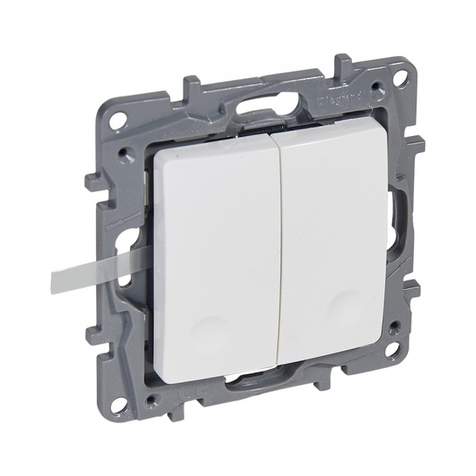
LEGRAND
LEGRAND 0 746 85 manual
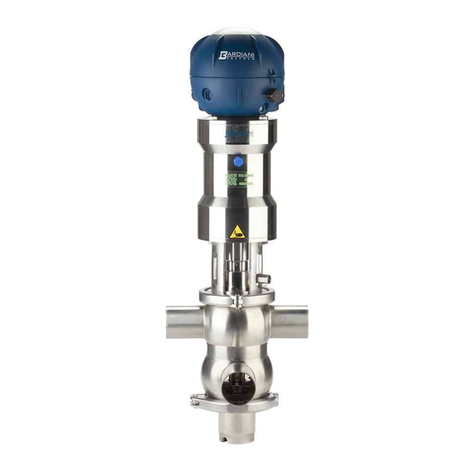
Bardiani Valvole
Bardiani Valvole B925 Instruction, use and maintenance manual
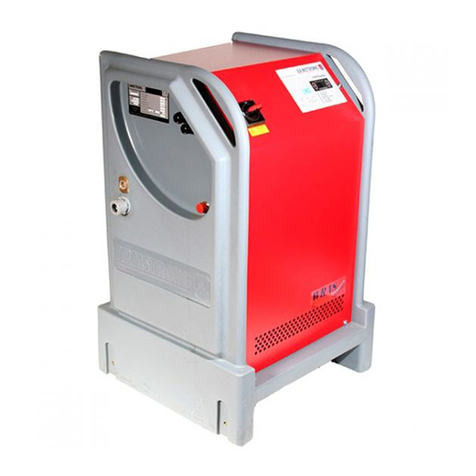
Armstrong
Armstrong 3750 Installation and operating instructions

Keithley
Keithley DDA-08 user guide
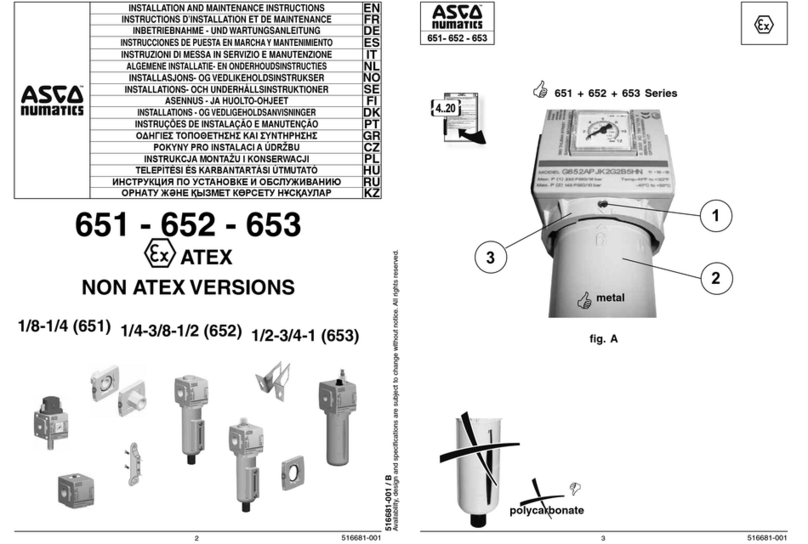
ASCO Numatics
ASCO Numatics 651 Series Installation and maintenance instructions
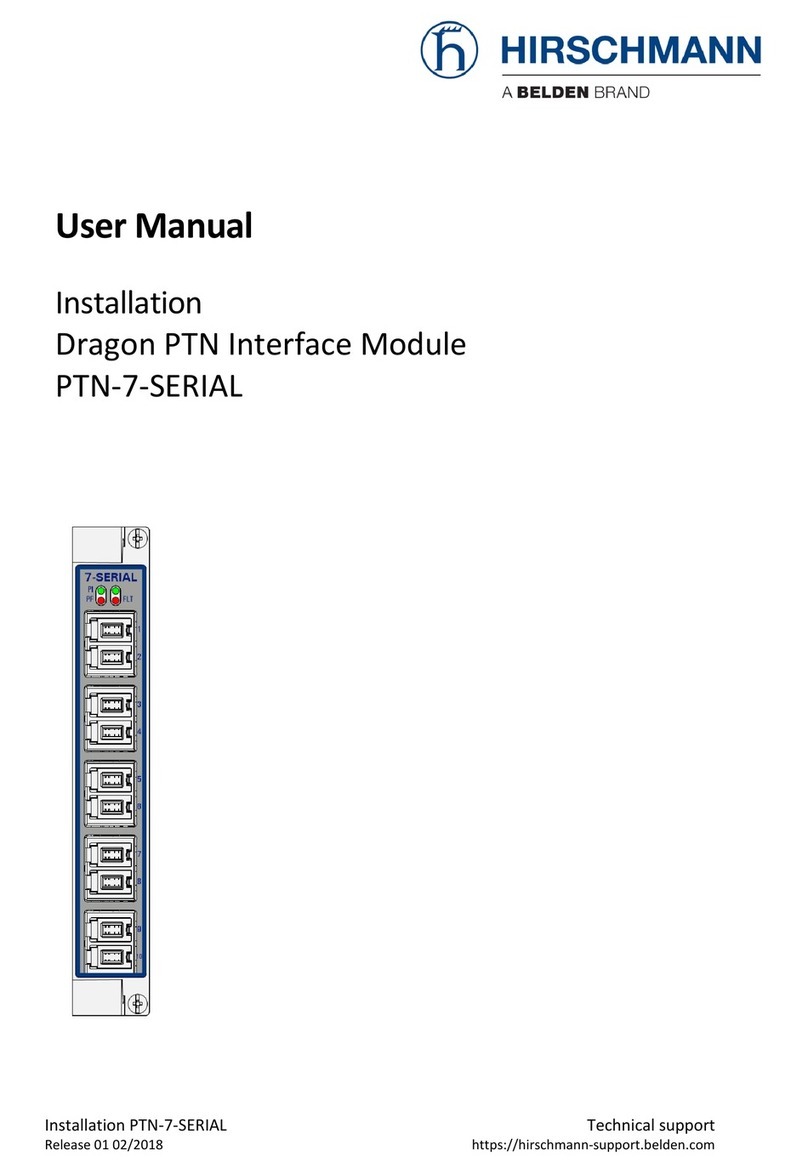
Hirschmann
Hirschmann PTN-7-SERIAL user manual
